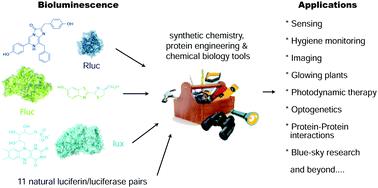当前位置:
X-MOL 学术
›
Chem. Soc. Rev.
›
论文详情
Our official English website, www.x-mol.net, welcomes your
feedback! (Note: you will need to create a separate account there.)
Applications of bioluminescence in biotechnology and beyond
Chemical Society Reviews ( IF 40.4 ) Pub Date : 2021-3-18 , DOI: 10.1039/d0cs01492c
Aisha J Syed 1 , James C Anderson
Chemical Society Reviews ( IF 40.4 ) Pub Date : 2021-3-18 , DOI: 10.1039/d0cs01492c
Aisha J Syed 1 , James C Anderson
Affiliation

|
Bioluminescence is the fascinating natural phenomenon by which living creatures produce light. Bioluminescence occurs when the oxidation of a small-molecule luciferin is catalysed by an enzyme luciferase to form an excited-state species that emits light. There are over 30 known bioluminescent systems but the luciferin–luciferase pairs of only 11 systems have been characterised to-date, whilst other novel systems are currently under investigation. The different luciferin–luciferase pairs have different light emission wavelengths and hence are suitable for various applications. The last decade or so has seen great advances in protein engineering, synthetic chemistry, and physics which have allowed luciferins and luciferases to reach previously uncharted applications. The bioluminescence reaction is now routinely used for gene assays, the detection of protein–protein interactions, high-throughput screening (HTS) in drug discovery, hygiene control, analysis of pollution in ecosystems and in vivo imaging in small mammals. Moving away from sensing and imaging, the more recent highlights of the applications of bioluminescence in biomedicine include the bioluminescence-induced photo-uncaging of small-molecules, bioluminescence based photodynamic therapy (PDT) and the use of bioluminescence to control neurons. There has also been an increase in blue-sky research such as the engineering of various light emitting plants. This has led to lots of exciting multidisciplinary science across various disciplines. This review focuses on the past, present, and future applications of bioluminescence. We aim to make this review accessible to all chemists to understand how these applications were developed and what they rely upon, in simple understandable terms for a graduate chemist.
中文翻译:

生物发光在生物技术及其他领域的应用
生物发光是一种引人入胜的自然现象,生物可以通过这种现象发光。当荧光素酶催化小分子荧光素的氧化以形成发光的激发态物质时,就会发生生物发光。目前有30多个已知的生物发光系统,但迄今为止,仅11个系统的荧光素-荧光素酶对已被表征,而其他新颖的系统目前正在研究中。不同的荧光素-荧光素酶对具有不同的发光波长,因此适用于各种应用。在过去的十年左右的时间里,蛋白质工程,合成化学和物理技术取得了长足的进步,这使得萤光素和萤光素酶可以达到以前未知的应用。现在,生物发光反应通常用于基因检测,小型哺乳动物体内成像。摆脱传感和成像技术,生物发光在生物医学中的应用的最新亮点包括生物发光诱导的小分子光解囊,基于生物发光的光动力疗法(PDT)以及使用生物发光来控制神经元。蓝天研究(例如各种发光设备的工程设计)也有所增加。这导致了跨学科的许多激动人心的多学科科学。这篇综述着重于生物发光的过去,现在和未来的应用。我们的目标是使所有化学家都能获得该综述,以了解这些应用程序是如何开发的以及它们所依赖的内容,这对于研究生化学家而言是简单易懂的术语。
更新日期:2021-03-19
中文翻译:

生物发光在生物技术及其他领域的应用
生物发光是一种引人入胜的自然现象,生物可以通过这种现象发光。当荧光素酶催化小分子荧光素的氧化以形成发光的激发态物质时,就会发生生物发光。目前有30多个已知的生物发光系统,但迄今为止,仅11个系统的荧光素-荧光素酶对已被表征,而其他新颖的系统目前正在研究中。不同的荧光素-荧光素酶对具有不同的发光波长,因此适用于各种应用。在过去的十年左右的时间里,蛋白质工程,合成化学和物理技术取得了长足的进步,这使得萤光素和萤光素酶可以达到以前未知的应用。现在,生物发光反应通常用于基因检测,小型哺乳动物体内成像。摆脱传感和成像技术,生物发光在生物医学中的应用的最新亮点包括生物发光诱导的小分子光解囊,基于生物发光的光动力疗法(PDT)以及使用生物发光来控制神经元。蓝天研究(例如各种发光设备的工程设计)也有所增加。这导致了跨学科的许多激动人心的多学科科学。这篇综述着重于生物发光的过去,现在和未来的应用。我们的目标是使所有化学家都能获得该综述,以了解这些应用程序是如何开发的以及它们所依赖的内容,这对于研究生化学家而言是简单易懂的术语。































 京公网安备 11010802027423号
京公网安备 11010802027423号